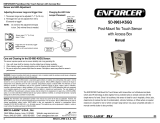
ENFORCER Outdoor Piezoelectric Request to Exit Pushbutton
2 SECO-LARM U.S.A., Inc
Specifications:
Ring LED
Colors reversible via switch
Weight
w/Manual
Override
4-oz (113g)
w/Manual
Override
3.1-oz (88g)
Parts List:
Piezoelectric push button ........................... x 1 Mounting screws .................................. x 2
Wires for manual override
1
........................ x 2 Manual ................................................. x 1
Overview:
SD-6176-SSVQ and SD-6276-SSVQ with Manual Override button shown, other models similar.
Installation:
1. Prepare wiring to provide 12~24 VDC power and connect devices to the relay outputs.
Note: The device includes one relay with two outputs. Outputs trigger simultaneously but can be
configured independently. To set the output modes, see Relay Output Modes on page 3.
2. Remove the plastic cover from the rear of the switch and carefully pierce the rubber grommet.
3. SD-6176-SSVQ and SD-6276-SSVQ: Wire the manual override button. See page 3.
4. Wire the switch according to the diagram on the right.
• Connect (-) and (+) to a 12~24 VDC power source.
• Connect other devices to Outputs 1 or 2.
5. Replace the plastic switch cover and screw the plate
onto the mounting surface.
1
SD-6176-SSVQ and SD-6276-SSVQ only.
Single-Gang
Slimline
4
1
/
2
”
(114mm)
LED ring
Manual
override
button
1
Piezo-
electric
pushbutton
1
5
/
8
” (42mm) 2
3
/
4
” (70mm) 1
5
/
8
” (42mm)
Side View
(Plastic switch
cover removed)
Relay adjust
Terminal blocks
1
Buzzer adjust
Timer adjustment
ENFORCER Outdoor Piezoelectric Request to Exit Pushbutton
SECO-LARM U.S.A., Inc 3
Wiring the Manual Override:
SD-6176-SSVQ and SD-6276-SSVQ Only
Connect the manual override button with the included wires.
Notes
a. Remove the thin panel on the bottom of the plastic cover to allow wiring to pass through.
b. There is only one relay, wiring the button to either output will allow the other output to trigger simultaneously.
c. Do not connect the manual override button to more than one output.
d. When wiring for either N.O. or N.C., be sure to also set the Relay Output Mode to N.O., as described below.
If Relay Output Mode and override button wiring do not match, the product may not function as expected.
Configuring the Pushbutton:
1. Buzzer Output DEFAULT: ON
Use the buzzer output jumper JP3 to program the buzzer output.
Placing the jumper on the left turns buzzer output ON. Placing the
jumper on the right turns buzzer output OFF.
2. Relay Output Mode DEFAULT: N.O.
Outputs 1 and 2 can be set independently using jumpers
JP1 and JP2. Note: Both outputs trigger simultaneously.
Place the jumper on the right for N.O. operation and on the
left for N.C. operation.
3. LED Ring Colors DEFAULT: OFF
ON: LED is green while in standby, and turns red when triggered.
OFF: LED is red while in standby, and turns green when triggered.
4. Switch Output Type DEFAULT: Timer
TIMER: When set to TIMER, pressing the switch will trigger the relay for
the set time. Set the time using the trimpot as described below.
TOGGLE: When set to TOGGLE, pressing the switch will cause the
relay to trigger until the switch is pressed again.
5. Timer Adjustment DEFAULT: 1s
Output duration is adjustable 1~30 seconds. (Must be set to ‘Timer’ in step 4
)
Gently rotate the trimpot using a Philips head screwdriver.
Counterclockwise decreases the output time.
Clockwise increases the output time.
Connect the two
wires between the
NO and COM
terminals of the
override button and
the Output 1 or 2
terminals on the
switch.
Connect the two
wires between
the NC and COM
terminals of the
override button
and the Output 1
or 2 terminals on
the switch.
N.O.
COM
N.C.
COM









